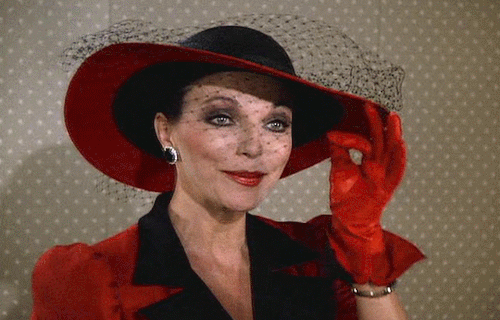Where Did TV's Villains Go? Monsters, Anti-Heroes And Alexis Colby Carrington
Old-school villains like Dynasty's Alexis Carrington Colby Dexter Rowan (Joan Collins) could always be counted upon to bring some melo- with the drama.
The New Golden Age of Television
in which we find ourselves is marked by a few spots of tarnish. There's
a sameness of tone (i.e. grim) and skin color (i.e. white), a tendency
to confuse violence (i.e. brutally assaulted women) for plot, and a
mystifying reluctance to let villains be villains.
A quick definition of terms: I'm talking about true villains,
here. Not bad guys — those gun-toting heavies who show up every week to
supply a given episode with its necessary conflict. Bad guys say things
like "get in the car" and "you gotta smart mouth" and "the boss wants
them taken care of." They're interchangeable, predictable, boring.
And let's take monsters off the table while we're at it. Television has always loved its monsters, on shows like Kolchak: The Night Stalker, The X-Files, Buffy The Vampire Slayer, Angel, True Blood, Teen Wolf, Grimm, Supernatural and Sleepy Hollow.
It was the old David Lynch/Mark Frost series Twin Peaks,
which will return next year following a 26-year hiatus, that featured
easily the single-most terrifying monster in TV history: Killer Bob.
Who it turned out was actually a sort of murderous ... forest ... spirit?
... In stone-washed denim.
Look, it was the 90s.
Like
all the werewolves and vampires and ghosts that haunt TV shows today,
Bob was a fairy-tale boogeyman, a metaphor, a larger-than-life symbol of pure evil. Not a villain.
The thing about villains is that they are entirely human, outfitted with understandably human motivations.
What's more, they have a plan. That's what truly
separates them from generic bad guys and monsters: TV's best villains
play the long game. Episode after episode, season after season, they
plot and scheme and wait, tenting their fingers.
And not only do they have a plan, they're only too happy to share it with anyone in earshot.
Take Alexis Colby — technically Alexis Carrington Colby Dexter Rowan — of the '80s nighttime soap Dynasty, played with scenery-chomping relish by Joan Collins:
The past is over and nothing can change it, but let me tell you something, Krystle. The future is going to be very different, because in a very short time, this faultless family is going to be hearing from me — including you! And you especially are going to cringe at what you hear! Krystle Jennings Carrington! The oh-so-sterling once — and maybe future — secretary!
TV
used to be lousy with villains like Alexis. Villains who sat at the
very center of the spider web, patiently spinning plans within plans.
But then something happened.
Tony Soprano happened. And Vic Mackey. And Walter White. And Don Draper, Francis Underwood, Nancy Botwin, Jax Teller, and...
Anti-heroes
happened; the bad guys became our good guys. We started building shows
around ruthless mobsters, drug kingpins, womanizing cads. They do lots
of villainous things — Tony Soprano murdered his own nephew, for pity's
sake — but now they're the characters with whom we're meant to identify.
To be sure to keep our sympathies, writers are careful to show
these anti-heroes forever struggling with their actions.
But villains —
true villains — don't struggle with the evil that they do. They bask in it. Here's Alexis again:
If I ever hear of another time when she has breathed a word
about Fallon's paternity, I will personally attach tiny hand grenades
to each of the wheels on her roller skates, watch her do one of her
ever-loving pirouettes, and applaud as she explodes into a thousand smithereens!
Trust me, you can hear it in her voice: Evil is her bubble bath, and she's luxuriating in it up to her neck.
Granted, the many anti-hero shows we have today are a lot more nuanced and wise about the human condition than a show like Dynasty ever was. Of course they are. But they're also a lot less fun.
That's because we intellectually empathize with an anti-hero ... but we love a hiss-worthy villain.
That's key to understanding why The Walking Dead and Game of Thrones
are two of TV's most-watched programs right now. Not because of their
monsters — the zombies and fire-breathing dragons are gimmicks — but
because they both feature old-fashioned villains: men and women with
elaborate plans, who are fun to watch.
For two seasons on The Walking Dead
a character called The Governor proved himself a unimaginably nasty
villain to the show's main characters; when it returns in October, look
for a character called Negan to fill that slot, in a particularly brutal
fashion.
And of all the many characters on Game of Thrones,
it's only Cersei Lannister, Queen of the Seven Kingdoms, who positively
revels in the kind scheming, self-satisfied, unapologetic villainy TV
used to do so well:
The only way to keep the
small folk loyal is to make certain they fear you more than they do the
enemy. Remember that, if you ever hope to become queen.
See? That's more like it. I perhaps don't need to point out that as she says all that, she swirls and guzzles a huge goblet of red wine.
Alexis would be proud.









No comments:
Post a Comment